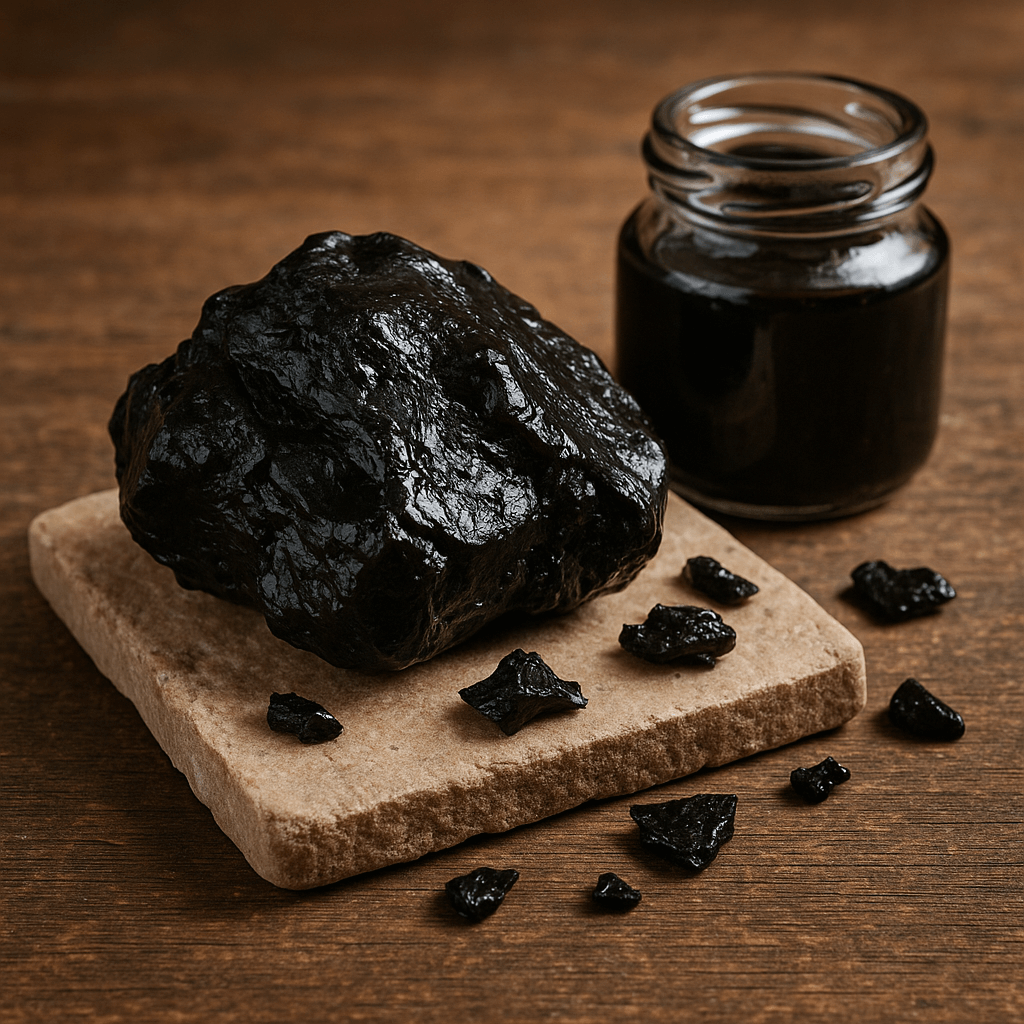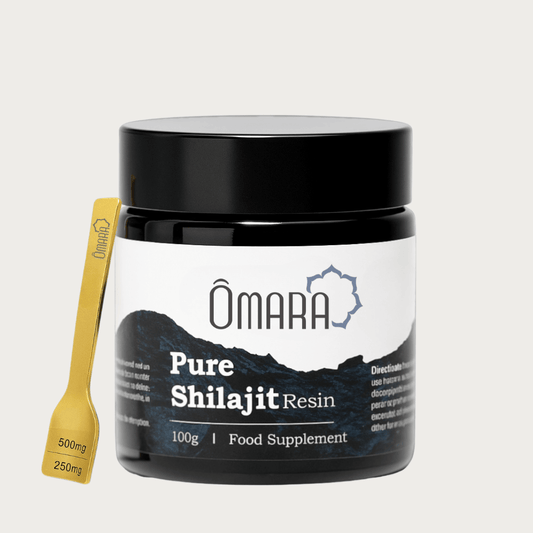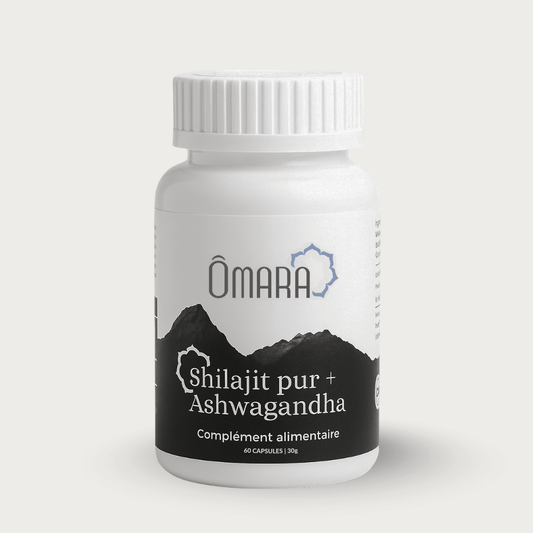
Humic Acid: An Essential Ally for the Earth and Health
Share
In the vast and complex world of organic matter, humic acids stand out as fundamental components, playing a crucial role in soil fertility and promoting human health. Often overlooked by the general public, these natural substances, found notably in shilajit , a precious resin used in Ayurvedic medicine, are at the heart of essential biological and chemical processes. This article explores in depth what humic acids are, their origin, their unique properties, and their applications, with a particular focus on shilajit, a natural treasure rich in humic and fulvic acids, used in agriculture and nutraceuticals.

Definition and Origin
Humic acids are complex organic macromolecules, ranging in color from black to dark brown, that constitute a major fraction of humus, the stable organic matter in soil. They are the end product of the decomposition of plant and animal matter by microbial and chemical processes over millions of years. These substances are particularly abundant in soils rich in organic matter, peat, lignite, leonardite, and in substances such as shilajit, a resin formed in mountain rocks, particularly in the Himalayas. Their formation is a slow and continuous process, essential for the creation of fertile soils.
Chemically, humic acids are high-molecular-weight, negatively charged polymers with a typical composition of 50-60% carbon, 30-40% oxygen, 4-6% hydrogen, and 1-4% nitrogen. They result from the oxidative condensation of phenolic compounds (such as tannins) and are bound to other organic molecules such as amino acids, peptides, and polysaccharides. Compared to fulvic acids, also present in large quantities in shilajit (up to 20-30% of its composition), humic acids are less rich in oxygen but possess a high water-holding and cation-exchange capacity, with a cation-exchange capacity (CEC) of up to 400-600 cmol/kg.
Properties and Structure
Humic acids are characterized by their low mobility in soil, which allows them to form stable complexes with other soil components, particularly clay. This association gives rise to the clay-humic complex, a fundamental structure for soil stability and fertility. Thanks to their numerous hydrophilic functional groups, particularly carboxyl (-COOH) and hydroxyl (-OH) groups, humic acids have an exceptional capacity to retain water, being able to absorb up to fifteen times their own weight. This property is crucial for improving a soil's useful water reserve, making it more resilient to periods of drought.
There are two main types of humic acids based on their solubility and interaction with soil minerals: gray humic acids, which form very stable complexes with clay, and brown humic acids, which are relatively less stable. The molecular structure of humic acids, also present in shilajit, is characterized by aromatic rings interconnected by aliphatic chains, with an estimated carboxyl group content of 2-6 mmol/g. This structural complexity is the origin of their versatility and their ability to interact with a multitude of substances in the environment.
Humines
Humins are another class of humic substances, closely related to humic acids. The main distinction lies in their insolubility. Unlike humic acids, humins do not dissolve in water and are tightly bound to inorganic soil materials. They are the result of secondary mineralization of humified organic matter and represent the most stable and least mobile fraction of humus. Their structure is similar to that of humic and fulvic acids, with aromatic rings and aliphatic chains, but their insolubility makes them less directly available for biological and chemical interactions.
Research Area
The exact nature and structure of humic substances, including humic acids, remains a subject of research and debate within the scientific community. For a long time, they were considered large polymeric macromolecules with a molecular weight of 10,000 to 100,000 Da. However, recent studies, such as those published in the Soil Science Society of America Journal (2018), suggest that they may be associations of smaller molecules (500–2,000 Da), aggregated by non-covalent forces. These fragments, often resulting from the enzymatic depolymerization of lignins and tannins, possess hydrophobic (aromatic nuclei) and hydrophilic (acidic and alcoholic functional groups) parts, allowing them to aggregate or bind to soil minerals. This evolving understanding is essential to better understand their functions, particularly in substances such as shilajit, and to optimize their applications.
Agricultural Applications
Humic acid is a leading natural biostimulant in agriculture, offering a multitude of benefits for soil health and plant growth. Its action is manifested on several levels:
- Improved soil fertility : Humic acids promote beneficial microbial activity in the soil, increasing microbial biomass by 20-30% according to a study by Applied Soil Ecology (2019). They improve soil structure, increasing its water and air holding capacity, which is crucial for root development.
- Optimizing nutrient absorption : Thanks to their chelating capacity, humic acids bind to metal ions (iron, zinc, manganese, copper, etc.), increasing their bioavailability by up to 70% in some cases ( Journal of Plant Nutrition , 2020). This prevents nutritional deficiencies and optimizes fertilizer efficiency.
- Soil detoxification : They can chelate and immobilize heavy metals such as lead or cadmium, reducing their uptake by plants by 50-80% ( Environmental Science and Pollution Research , 2021).
- Stimulation of plant growth : Studies, such as those published in Plant and Soil (2017), have shown that the application of humic acids can increase the aerial and root biomass of plants by up to 25%, improve seed germination and strengthen crop resistance to stress (drought, salinity, diseases).
- Prevention of phosphate precipitation : By neutralizing aluminum and iron solubilized by acidifying fertilizers, humic acids prevent phosphate precipitation, increasing their availability by 30-40% ( Soil Science , 2018).
In short, humic acid helps create a healthier and more productive soil environment, reducing dependence on chemical inputs and promoting more sustainable agriculture.
Health Applications
Beyond its benefits for agriculture, humic acid is attracting growing interest in the field of human health, particularly in nutraceuticals. Its unique properties give it a wide range of therapeutic potential:
- Improved mineral absorption : Humic acid facilitates the transport and assimilation of minerals such as iron and zinc, increasing their bioavailability by up to 60% in in vitro studies ( Journal of Trace Elements in Medicine and Biology , 2020).
- Digestive support and detoxification : It can bind to toxins and heavy metals, reducing their concentration in the body by 40-50% in animal models ( Toxicology Reports , 2019), and promote elimination, thus supporting digestive health.
- Anti-inflammatory properties : Preliminary studies ( Inflammation Research , 2021) suggest that humic acid reduces inflammatory markers like TNF-α by 20-30% in cellular models, which may help relieve osteoarthritis or other inflammation.
- Strengthening the immune system : Humic acids stimulate the activity of macrophages and T lymphocytes, enhancing the immune response in in vitro studies ( Immunobiology , 2020).
- Antioxidant potential : They neutralize free radicals, reducing oxidative stress by 15-25% in in vitro tests ( Antioxidants , 2022).
Shilajit: A Natural Source of Humic and Fulvic Acids
Shilajit, a natural resin harvested from the mountains, particularly in the Himalayas, is an exceptional source of humic (10-20%) and fulvic (20-30%) acids. Used for centuries in Ayurvedic medicine, shilajit contains more than 85 minerals and trace elements, including iron, magnesium, and zinc, according to spectroscopic analysis ( Journal of Ethnopharmacology , 2016). A study published in Phytotherapy Research (2019) showed that shilajit increases energy levels by improving mitochondrial function by 20-30% in animal models, thanks to its fulvic acids. Its antioxidant properties reduce oxidative stress by 30% in in vitro tests ( Oxidative Medicine and Cellular Longevity , 2020), while its anti-inflammatory effects decrease inflammatory markers by 15-25% ( Journal of Medicinal Food , 2018). Shilajit also promotes detoxification by removing heavy metals like lead by up to 40% in animal studies ( Environmental Toxicology , 2021). Its unique composition makes it a valuable supplement for vitality, immunity, and overall well-being.

Although research on the applications of humic acid and shilajit in human health is still ongoing, preliminary results are promising and open the door to new perspectives for well-being.
Omara's Commitment
"In 2007, I climbed my first Himalayan pass. In 2011, in a Tibetan kitchen, an amchi offered me a pinch of shilajit: my heavy legs became light. No middleman, no overexploitation: just the mountain, my 16 years of experience, and the assurance that what I offer is pure, traceable, and ethical."
— Maurin, founder of Omara
Our shilajit comes exclusively from the heights of the Himalayas, harvested using traditional methods by families we've known personally for years. Each resin is purified using age-old techniques and analyzed by independent laboratories to ensure its purity and pharmaceutical quality.

Discover the Power of Shilajit with Omara.bio
Ready to incorporate the benefits of shilajit into your daily life? At Omara.bio , our authentic shilajit, sourced directly from the Himalayan Mountains, is rich in humic and fulvic acids to support your energy, immunity, and overall well-being. Boost your vitality naturally and discover optimal health with our high-quality shilajit.
Explore our range of authentic ShilajitConclusion
Humic acids, found in substances like shilajit, are key players in life on Earth. Their fundamental role in soil formation and fertility, supported by studies showing measurable improvements in biomass and nutrient bioavailability, makes them essential components of sustainable agriculture. Beyond their agronomic applications, their chelating, anti-inflammatory, and antioxidant properties, particularly via shilajit, open up fascinating perspectives in the field of human health, with studies confirming benefits for energy, immunity, and detoxification. By understanding and leveraging these natural substances, we can work towards healthier soils and more resilient organisms, in harmony with our planet's natural cycles.



